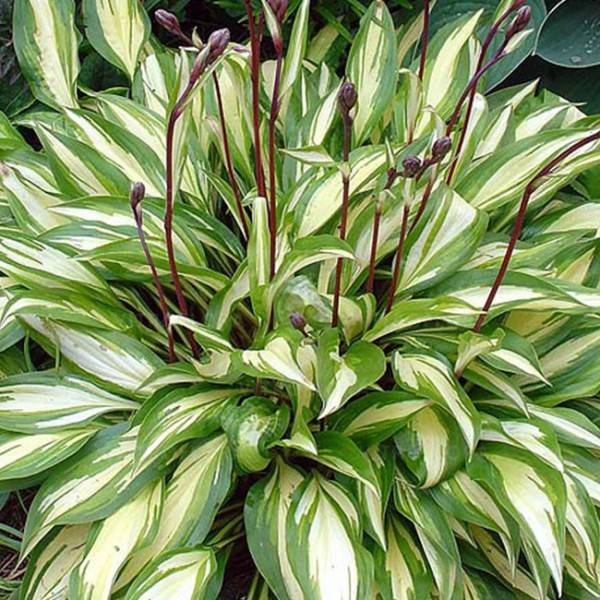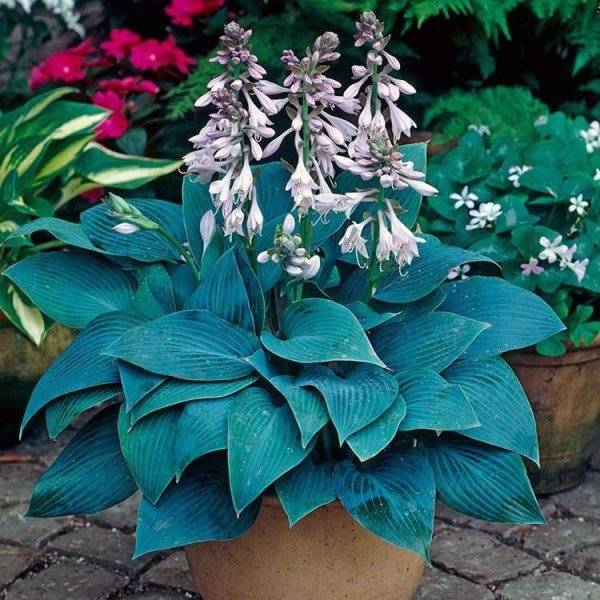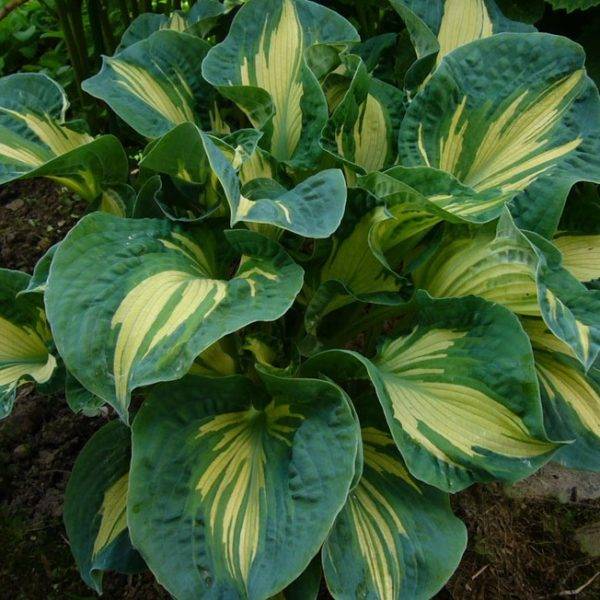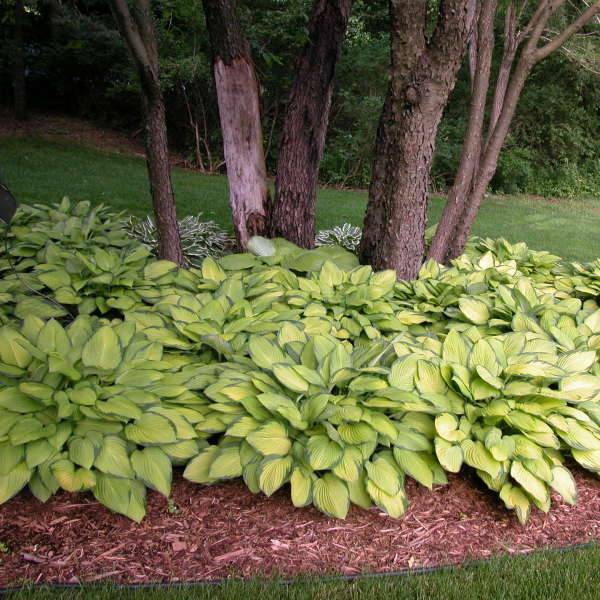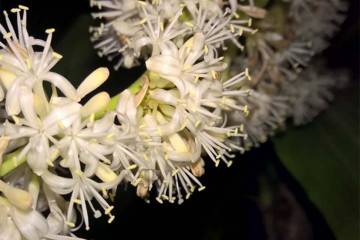Hosts - varieties and types
Content:
The variety of hosta species does not leave anyone indifferent - even those who are skeptical about landscape gardening and an alpine slide. There are about 80 plant subspecies in the world, breeding work to increase their number is ongoing. A feature of the flower is considered to be leaves that have beautiful shapes and a spotted or striped color. It does not require complex processing work, it is one of the most unpretentious plants in the garden.
Hosts - varieties and types
The bushes of the plant are shade-tolerant - it owes the merit of such properties to the painstaking work of gardeners from all over the world. According to the American classification, the hosta varieties and species are subdivided:
- on the dwarf type - with a height of up to 10 cm;
- miniature - up to 15 cm;
- small - up to 25 cm;
- medium height - up to 50 cm;
- large - up to 70 cm;
- giant - over 70 cm.
Hosta blue
It got its name from its unusual leaves, which are distinguished by a bluish tint. Incorrect care of this beauty leads to the disappearance of the non-standard color, the foliage becomes greenish. Hosta blue is the general name of a plant that has several subspecies under its own names.
- Abiqua Drinking Guard - characterized by dense, cupped leaves with deep embossed stripes and a waffle texture. In the middle of summer, it pleases with white flowers 2-3 cm in diameter. It is resistant to frost, does not plant near trees. Falling foliage from them into the "bowls" of the host will attract unnecessary attention of pests to it.
- Baby Bunting is one of the smallest hosts with bluish leaves. Requires planting in moist soils with good drainage, it tolerates heat worse than cold. It is distinguished by foliage in the form of pointed hearts, on the surface of which a clear relief pattern is visible. Flowering time - mid-summer, flowers resemble pale lavender bells.
- Blue Mouse Eyers is a miniature subspecies that appeared in 2000. The unusual shape of the foliage gave the name "blue mouse ears" or Blue Mouse Ears. Prefers to grow in diffused light or partial shade, does not die in the shade. Planting in brightly lit areas can cause severe burns to the plant and loss of unusual shade. Flowers appear in July - light lilac racemose inflorescences.
- Blue Angel - refers to the giants, with proper supervision it grows up to 1.5 m in diameter and 1 m in height. Not afraid of dry soils, it is one of the best blue-greenish options. Hosta inflorescences are racemose, cone-shaped, the color varies from pale lavender to white.
- Blue Shadows - has foliage with a bright light greenish core and dark bowl-shaped edges. When buying bushes for the effect of "crocodile skin", the formation of bubbles should be expected no earlier than 3-4 years of life. If the conditions of the initial planting are violated, three-fold mineral feeding during the season of exotic beauty in the form of bubbles on the leaves can not be expected.
- Love Pat - Plaid blue hosta with cupped foliage can thrive in brightly lit areas. Even under such conditions, its bright color does not fade. The appearance of the "crocodile skin" effect should be expected in the first years after the planting of the bushes.
- Francis Williams - characterized by bicolor concave leaves, with a shade of dark green in the middle and yellow-light green at the edges. How the hosta blooms: flowers are collected in a brush of 8 pieces, each in diameter does not exceed 5 cm. Inflorescences are on a short stem.
Hosta Golden Meadows
It has dense, large leaves, with slight waviness at the edges. They are painted in green-gray color, the core is of a creamy shade. The border of the leaf is blue, feathery, rather wide. The color scheme of the center of the leaf changes according to the season:
- in spring - golden;
- in summer - cream;
- closer to autumn - greenish.
Hosta Golden Meadows differs from its counterparts in the twisting of rounded leaf plates (15 by 23 cm in size) and color changes in the spring-summer period. The standard plant height is 60 cm, the growth in width occurs gradually.
Hosta Liberty
It is a long-lived perennial plant, erect shrubs up to 70 cm high and up to 80 cm wide.Large, highly raised foliage is distinguished by:
- texture and thickness;
- size - 22 by 32 cm;
- a shade of dark green with a touch of bluish;
- an uneven, wide border of golden color - by the middle of summer changing to white-cream.
Initially, the leaves are yellow, when untwisted they acquire a standard color. Hosta Liberty begins to bloom in July-August. The peduncles have a rich burgundy color, the length is up to 70 cm, they rise above the bushes. Bell flowers are lavender or light lilac in color.
White host
It has many varieties, where the main color is present in large volumes. Common plant subspecies include:
- Patriot is one of the largest subspecies, with a height of up to 70 cm. The foliage has a jagged border with a white tint, the core is dark green, wavy. In the middle of summer, the bush is decorated with small lilac flowers.
- White feathers are young leaves of a creamy white color, 15 cm long. As they develop, greenish stripes appear on them, covering almost the entire leaf area by the end of the season. Lavender flowers, almost white, enliven the garden from July to September. The bushes are not afraid of shade, cold weather, are practically not susceptible to disease, do not require complex care.
- Mediovariegata - along the edges of the leaves are the color of light green, the middle is almost white. Flowers with a light purple or bluish color, up to 5 cm in size. The length of the peduncles reaches 80 cm. The bushes can grow in one place without transplanting for up to 10 years in a row.
Hosta Siebold
Corrugated sheet with an interesting texture. Leaves are oval or ovoid, wide and dense. The waxy coating on the leaves gives them a bluish tint. Loves shady areas with moist soil. Hosta Siebold has its own subspecies, for example, Elegance - with a large number of flowers and embossed leaves, and Pauls Glory - a bright yellow shrub with a dark green border.
Real decorativeness comes to the plant by the age of 4 years, full splendor - not earlier than after 8 years. The unsightly and small bush turns into the empress of the flower garden. More suitable for a shady garden - due to the direct rays of the sun, the foliage loses its interesting shade of blue, becomes the usual greenish color.
Hosta Halcyon
Refers to the representatives of the blue host with an unusually bright color, which persists until mid-summer. The bushes 50 cm high have a heart-shaped foliage (10 by 16 cm), with a dense texture and deep longitudinal grooves. There are practically no leaves on the peduncles, their length is 80 cm, the width is almost 70 cm. The flowers have a funnel-shaped form of a characteristic purple hue, they persist for three weeks, in July-August.
Hosta Big Daddy
Shrubs grow up to 65 cm, have large cup-shaped leaves. Throughout the season, the plant retains a dark blue color, brightens only when exposed to direct sunlight. The Big Daddy hosts have white flowers. Bushes grow slowly, in one place they live from 10 to 15 years in a row.
Khosta June
An interesting feature of the June hosta is the change in color during one season. At the end of spring, the foliage is yellowish, with a subtle greenish print around the edges; closer to autumn, it acquires a bluish tint with a small light green spot in the middle. The shrub grows up to 40 cm in height and 70 cm in width, blooms from July to the end of August, the color of the flowers is lavender.
Hosta Brim Cap
Loose bushes, reaching 40 cm in height, with leaf plates 13 by 16 cm, elongated, dark emerald color with a bluish tint and a yellow outer border, which eventually becomes soft cream. The inner part of the leaf has a matte surface and a bluish color.
The hosta subspecies Brim Cap begins to bloom in mid-July, the inflorescences are one-sided, form in funnels. Young flowers have a light blue color, fully opened buds are white. The stems of the peduncles reach 45 cm.
Hosta Gold Standard
Differs in ovoid foliage, blooms in the standard period - July-August. Flowers are located on long, up to 1 m, peduncles, lilac color. At the end of the season, seed pods form in their place - their brown color indicates ripening.
Hosta subspecies Gold Standard in spring is determined by the delicate greenish color of the leaves with a dark strip of border, after June their shade changes to golden. The height of the bush is 70 cm, the width is up to 1.2 m.
Hosta Wide Brim
Hosta subspecies Wide Brim is considered a beautiful, showy and unpretentious plant. Grows calmly in shaded and semi-dark areas, does not require additional shelter in winter. The planting of bushes is carried out next to the tree trunks.
The leaves are bluish-blue with a light green border, the flowers are lilac. The plant grows in height from 30 to 60 cm, in diameter - from 60 cm to 1 m. Blooming of flowers begins in July and ends in August.
Hosta First Frost
A herbaceous hybrid belonging to the Liliaceae. Hosta is common in Japan, the Far East, and East Asia. She has a medium size, unusual milky edging on the leaf plates. In the spring, the border has a more yellow tint, with the onset of heat it turns pale. The size of an adult bush does not exceed 40 cm in height and 80 cm in length.
First Frost hosts have compact bushes, there are no broken leaves. Hard and rough foliage practically does not lend itself to damage from pests, has an unusual shade - bluish. The leaves are 20 cm long, 10 cm wide, located on petioles, forming a large rosette near the roots.
Hosta Stiletto
It is a miniature version of the host, with a dome-shaped shape, up to 35 cm in height. Oblong foliage with wavy edges has a standard color and a light border. The flowers have a light lavender color, the size is up to 5 cm, the length of the peduncle is up to 45 cm. It blooms from July to August.
Hosta variation Stiletto is afraid of direct sunlight, prefers darkened household plots. The shade of the foliage of the bush depends on the level of illumination - in the shade it is a shade of rich green, in the light it is lighter.
Hosta Orange Marmalade
Perennial bushes can grow in the same place for 20 years, becoming more lush and beautiful over time. An advantage of the Orange Marmalade hosts is the foliage, which changes the color range all season. According to the description:
- at the time of blooming - golden yellow;
- in early summer - bright orange;
- in the midst of the heat - cream.
Hosta blooms in July, inflorescences grow up to 1 m, have a lavender color. In cooler weather, the smell of flowers intensifies.
Hosta Golden Tiara
The Golden Tiara hosts have the following characteristics:
- width - up to 70 cm, height - up to 40 cm;
- leaves - heart-shaped, 13 by 11 cm, edged with a creamy yellow hue (the strip turns green in summer);
- flowers - lavender, striped or bluish-purple, appear in July-August.
The bush itself grows rapidly. Hosta tolerates cold well, but closer to winter it needs to be insulated with peat, wood chips or compost.
The above types are not able to cover the entire list of varieties of this beautiful plant. Everyone can choose the perfect composition of different types of flowers (plantain, yellow, lanceolate or Praying Hands hosta) that can decorate even a small area set aside for a garden.
